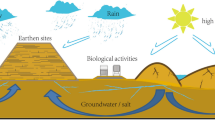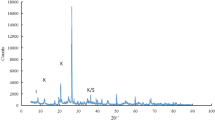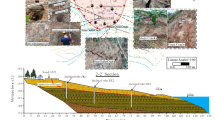Abstract
A CHARACTERISTIC feature of heavy soils such as the black cotton soil is their extensive cracking during summer fallow. Wide fissures are formed as a result of the shrinkage of the soil colloids under the baking action of the hot sun during summer months. These cracks vary from a fraction of an inch to 3-4 in. in width, and are often several feet in depth. It is generally recognized that cracking results in an improvement in the physical properties of the soil, but the factors which determine the character of cracking in field soils have remained rather obscure. Interesting information has been obtained in the course of a survey of the nature and extent of surface cracking in different fields under cotton in the Institute area. The technique adopted was as follows:
This is a preview of subscription content, access via your institution
Access options
Subscribe to this journal
Receive 51 print issues and online access
$199.00 per year
only $3.90 per issue
Buy this article
- Purchase on Springer Link
- Instant access to full article PDF
Prices may be subject to local taxes which are calculated during checkout
Similar content being viewed by others
References
Bouyoucos, G. J., Soil Sci., 18, 103 (1924).
Greene, H., J. Agric. Sci., 18, 518 (1928).
Vageler, p., "An Introduction to Tropical Soils" (London: Macmillan, 1933), p. 179.
Howard, A., "An Agricultural Testament" (Oxford, Univ. Press, 1940), p. 138.
Annual Report, Institute of Plant Industry, Indore (1937).
Ayyar, V. R., Ayyar, S. S., and Tirumalachari, N. C., Madras Agric. J., 28, 69 (1940).
Annual Report, Gezira Agric. Res. Ser., Sudan Govt. (1937).
Viswa Nath, B., Agric. and Live-stock in India, 8, 9 (1938).
Russell, E. W., and Keen, B. A., J. Agric. Sci., 28, 212 (1938); Keen, B. A., J. Min. Agric., 45, 645 (1938).
Howard, A., Agric. J. Ind., 22, 39 (1927).
Cited from Keen, B. A., "The Physical Properties of the Soil" (London, Longmans, 1931), p. 144.
Sreenivasan, A., NATURE, 148, 144 (1941).
Sreenivasan, A., and Aurangabadkar, R. K., Soil Sci., 50, 449 (1940).
Peele, T. C., J. Amer. Soc. Agron., 32, 204 (1940).
Martin, J. P., and Waksman, S. A., Soil Sci., 52, 381 (1941).
Author information
Authors and Affiliations
Rights and permissions
About this article
Cite this article
SREENIVASAN, A. FUNCTION OF SOIL CRACKS. Nature 150, 409–410 (1942). https://doi.org/10.1038/150409a0
Published:
Issue Date:
DOI: https://doi.org/10.1038/150409a0
Comments
By submitting a comment you agree to abide by our Terms and Community Guidelines. If you find something abusive or that does not comply with our terms or guidelines please flag it as inappropriate.



